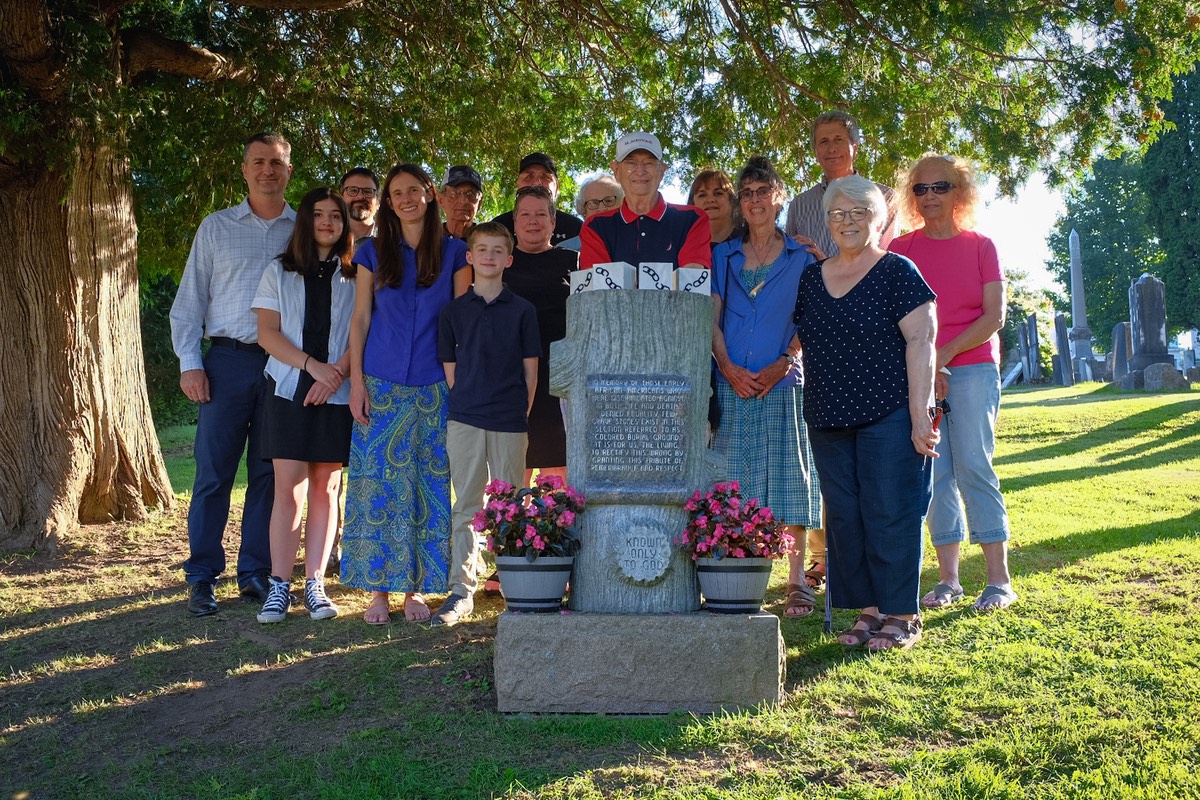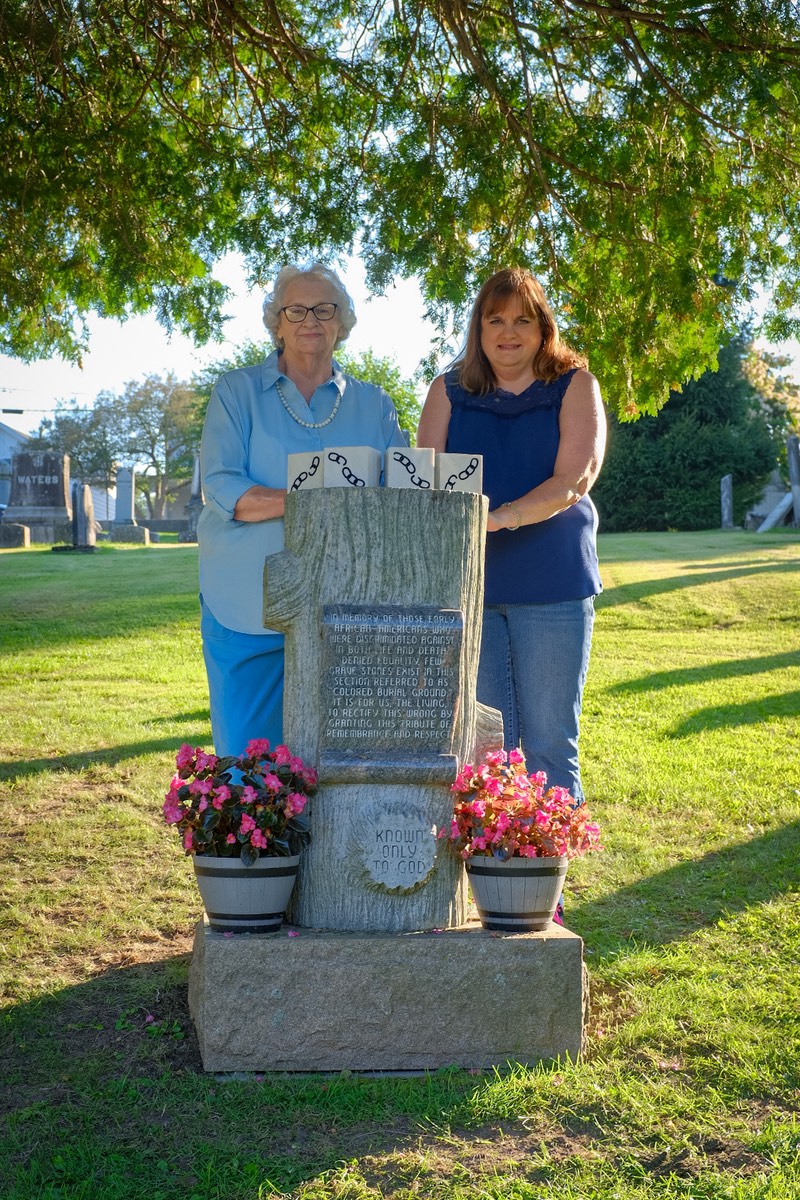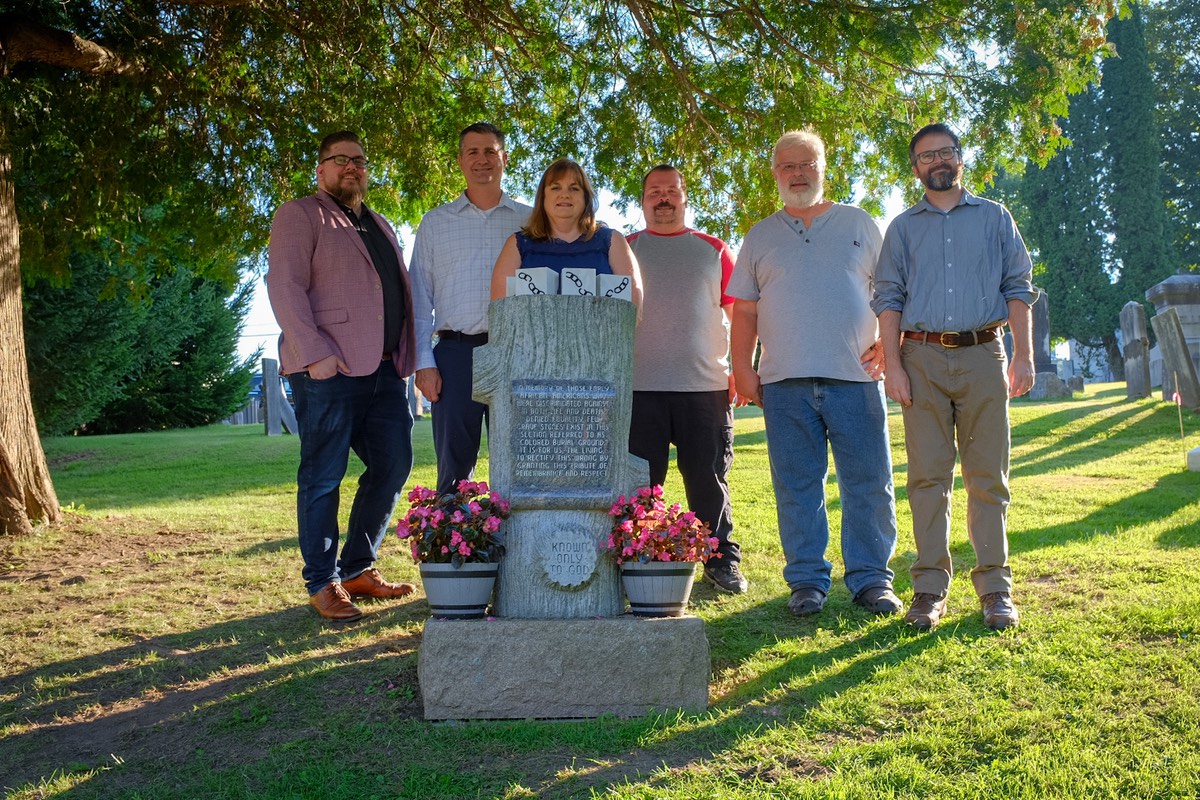From left to right: City Engineer Chet Szymanski, 2nd Ward Alderman and Common Council President Justin Welyczko, Dan Enea of Mohawk Valley Funerals and Cremations, 1st Ward Alderman Tim Lyon, Joan Vogt, 1st Ward Alderman Jonathon Shaffer, Louis Baum, Church Street Cemetery Caretaker Justin Ostasz, Patty Sklarz, David Krutz, Pat Frezza-Gressler, Jeffrey Gressler, and Pat Stock. [Photo by Sarah Rogers]
CITY AND HISTORICAL SOCIETY CONTINUE EFFORTS TO RECOGNIZE AFRICAN AMERICAN BURIAL GROUND
It all began sometime in the early-2000s in the mind and heart of deceased former City Historian Edwin Vogt. It was Vogt who conceived of the idea to formally recognize with a monument what was once known as the “Colored Burial Ground” in Church Street Cemetery, located in the City of Little Falls’ first ward.
City records indicate that at least seventy-seven Black Little Falls residents were interred in this area between 1838-1977, most buried in unmarked graves.
Vogt reached out to the Little Falls Historical Society in 2014 for assistance with his efforts. In turn, the Historical Society reached out to Harry and Kevin Enea of Burdick and Enea Memorials and a three-way collaborative effort between City government, the Eneas, and the Historical Society resulted in the installation of a monument and a 2015 dedication ceremony.
The tree stump monument’s inscription reads: “In memory of those early African Americans who were discriminated against in both life and death. Denied equality, few gravestones exist in this section referred to as ‘Colored Burial Ground.’ It is up to us, the living, to rectify this wrong by granting this tribute of remembrance and respect.”
The tree stump monument has had community resonance; an untold number of anonymous visitors to this site have left behind various small mementos to honor the people buried in this section.
And now back to the present.
Current efforts are focused on formally establishing the four corner boundaries of this cemetery section. Dan Enea of Mohawk Valley Funerals and Cremations has recently assisted in the acquisition of four granite markers for this purpose, each with an engraved broken chain symbolizing release from slavery.
Reaching back in time once more, the 1830 Village of Little Falls census listed eighty-five Black residents of the 1602 Village population. An 1881 census listed ten Black households, located mostly near the AME Zion Church on West Main Street, and the 1900 City of Little Falls census included sixty-six Black residents. Many of these residents are presumably buried in Church Street Cemetery.
Those readers interested in learning more about local Black history should go to the Little Falls Historical Society website where two relevant articles can be read and enjoyed. LOCAL AFRICAN AMERICAN HISTORY REFLECTED STATE AND NATIONAL EVENTS and THE UNDERGROUND RAILROAD IN AND AROUND LITTLE FALLS can be easily accessed on this website.
The recent Historical Society Canal Days Celebration gravesite tour of Church Street Cemetery included seven gravesites from the African American Burial Ground section. This cemetery tour can be downloaded from the same website. Hard copy brochures are also available on a stone bench near the cemetery caretaker’s cabin.
In closing, to quote Mayor Mark Blask: “The work being done to better recognize the African American Burial Ground section of Church Street Cemetery represents an attempt by the present generation to in part correct a past injustice. The City of Little Falls much appreciates these efforts.”
African American Monument, Church Street Cemetery, Little Falls, NY
[Photo by Sarah Rogers]

![From left to right: City Engineer Chet Szymanski, 2nd Ward Alderman and Common Council President Justin Welyczko, Dan Enea of Mohawk Valley Funerals and Cremations, 1st Ward Alderman Tim Lyon, Joan Vogt, 1st Ward Alderman Jonathon Shaffer, Louis Baum, Church Street Cemetery Caretaker Justin Ostasz, Patty Sklarz, David Krutz, Pat Frezza-Gressler, Jeffrey Gressler, and Pat Stock. [Photo by Sarah Rogers] From left to right: City Engineer Chet Szymanski, 2nd Ward Alderman and Common Council President Justin Welyczko, Dan Enea of Mohawk Valley Funerals and Cremations, 1st Ward Alderman Tim Lyon, Joan Vogt, 1st Ward Alderman Jonathon Shaffer, Louis Baum, Church Street Cemetery Caretaker Justin Ostasz, Patty Sklarz, David Krutz, Pat Frezza-Gressler, Jeffrey Gressler, and Pat Stock. [Photo by Sarah Rogers]](https://littlefallshistoricalsociety.org/wp-content/uploads/2023/09/IMG_2445.jpeg)
![African American Monument in Little Falls, NY [Photo by Sarah Rogers]](https://littlefallshistoricalsociety.org/wp-content/uploads/2023/09/IMG_2447.jpg)



![Dan Enea and Louis Baum holding Broken Chain Grave Markers [Photo by Sarah Rogers] Dan Enea and Louis Baum holding Broken Chain Grave Markers [Photo by Sarah Rogers]](https://littlefallshistoricalsociety.org/wp-content/uploads/2023/09/IMG_2448.jpeg)


